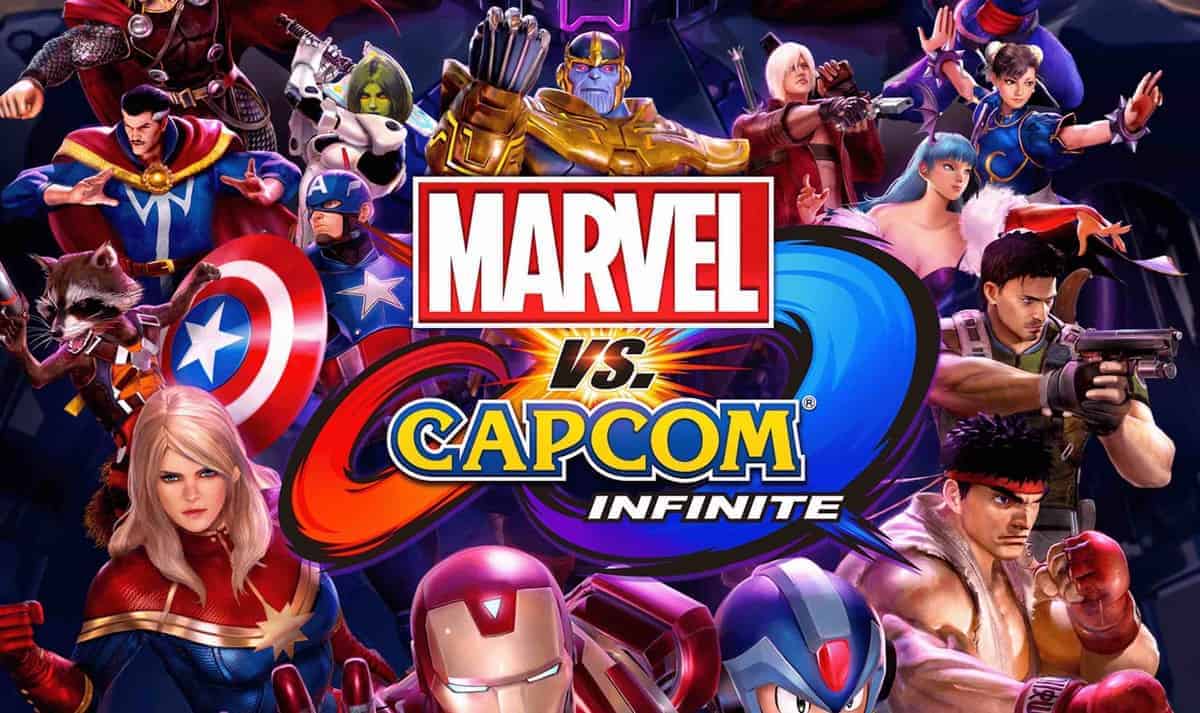It wasn’t that long ago when all available Marvel vs Capcom games got pulled from digital distribution when Capcom’s publishing license expired at the end of 2013, and it was believed by most that the famed franchise had come to an end with Ultimate Marvel vs Capcom 3. It was therefore a huge surprise when Marvel vs Capcom Infinite (MvCI) was announced at PlayStation Experience 2016.
Even though Marvel vs Capcom Infinite is the spiritual sequel to Marvel vs Capcom 3, it is actually the 8th entry into Capcom’s Marvel fight games, a lineage that started with the excellent X-Men: Children of the Atom, which came out more than two decades ago in 1994.
Children of the Atom was the first game of its kind to include a combination of animated cartoon art style, flashy special moves, screen filling supers, roles, air-dashes and long juggle-based combos; the game started a grand legacy of Capcom’s Marvel-based fighting games that are beloved for the unique experience brought on by its huge roster of iconic characters and fast paced gameplay.
With recent chatter about sub-par character models and an apparently unimpressive character roster, Marvel vs Capcom Infinite has a lot to prove and answer the question whether it is a worthy entry into the esteemed Marvel vs Capcom (MvC) franchise, or is it just a crash grab that sullies the legacy of Capcom Marvel fighters, and is there just to provide further exposure to Marvel movie characters?
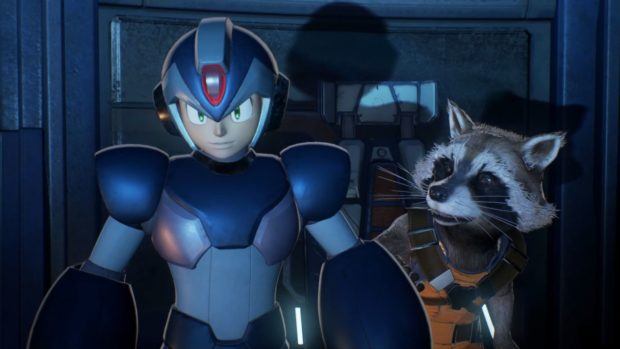
Let’s start with the first thing that comes to notice when starting Marvel vs Capcom Infinite; the quality of its visuals, its graphics and the choice developers made for its art design and character models.
MvC is a franchise that has thrived on the strengths of its visual presentation. For its first 5 games, from X-Men: Children of the Atom all the way to Marvel vs Capcom 2, the games’ character models and environmental art design were based on the iconic 90’s X-Men cartoon show. The style very much suited the source material and was accompanied with amazing sprite work and wonderfully flashy animations.
Come 2011, Marvel vs Capcom 3 took its visuals into another direction and brought 3D models into the fold; and although that design choice didn’t hold a candle to the previous art style, it still tried to do something interesting with its Cell-Shading and Inky outlines to create visuals close to the comicbook art.
Even though Marvel vs Capcom Infinite takes the similar 3D design approach to MvC3, it is clearly the worst the franchise has ever looked when it comes to the character and art design. Let’s be clear, MvCI doesn’t have bad graphics and its character models aren’t bad per-say, it’s just that the character designs and whole art direction are plain bland and totally uninspired.
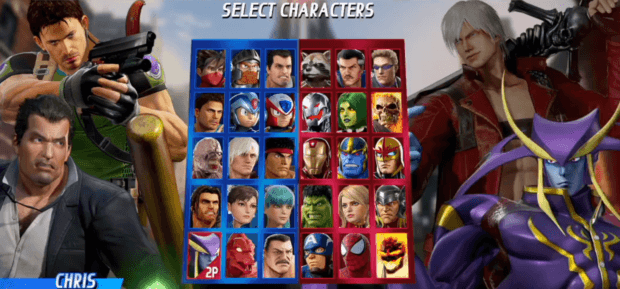
Even the User-Interface suffers from the same problem. Although all the selection screens and option menus are sleek and clean looking, their design is merely functional and remains lack-luster; It clearly misses the boat on incorporating some elements from the huge amount of content on both Capcom and Marvel side that could have been source of inspiration for a better, more creative approach to menus and selection screens.
Stages are a saving grace for MvCI. They depict merged universes and worlds from Marvel canon and Capcom games, many of which contain lots of easter eggs from past Capcom games as well as Marvel comic characters and story arcs.
Unfortunately, as far as Marvel vs Capcom Infinite’s visuals are concerned, the only part of the presentation that looks better than the previous MvC games are the flashy light, energy, sparks and particle effects that fill the screen during every special, super and hyper combo move.
But even with that series’ staple flashy graphics, the art direction looks downright dull compared to its equally flashy upcoming 2v2 fighting game competitor; Dragon Ball FighterZ. It is disheartening to see Capcom falter in its art direction even with decades of experience in producing comic-based fighting games, whereas Arc System Works was able to perfectly bring the manga/cartoon visuals of Dragon Ball franchise to life on its first attempt.
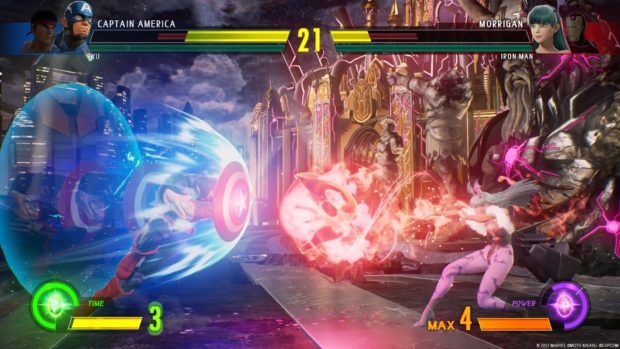
Setting aside its visuals, the second most readily noticeable part of any fighting game is its roster. It is usually what attracts players to give the game a try and for some, it is the most important aspect of any game in the fighting game genre.
Marvel vs Capcom Infinite features a roster of 30 characters; 15 characters from past Capcom games and 15 comicbook icons from Marvel side. While this roster might appear large when compared to other fighting games, however it is quite anemic as compared to last to two games in the franchise which featured 56 playable characters in MvC2 and 48 in UMvC3.
The Capcom side of the roster features an eclectic mix of mostly returning characters that represent a wide range of Capcom properties like Arthur from Ghosts & Goblins, Chris and Nemesis from Resident Evil, Strider Hiryu from Strider, Dante from Devil May Cry, Rad Spencer from Bionic Commando, Firebrand from Gargoyle’s Quest, Frank West from Dead Rising, Haggar from Final Fight, Zero from Mega Man, Morrigan from Darkstalkers, and of course Ryu and Chun-Li from Street Fighter series.
The game’s new additions to the MvC series include the addition of X version of Mega Man from the Mega Man X games and Jedah from Capcom’s Darkstalkers fighting game series, as well as Ultron (Avengers: Age of Ultron), Captain Marvel and Gamora (Guardians of the Galaxy) from Marvel side.

Speaking of Marvel side, it is fully transparent what criteria was used to pick and choose its characters, as the Marvel side of the roster is clearly based on portraying the movie franchise of the Marvel Cinematic Universe, with every character having a presence in a recent Marvel Studios movie release or focus of an upcoming movie.
Whereas the Capcom side of the roster does contain omissions of some fan-favorites like Akuma, Jill Valentine and Ken Masters, on the other hand, the Marvel side seems to have gone through a culling as most of the staples of the franchise are absent from the game’s roster.
Conspicuous by their absence are characters that have been synonymous with MvC franchise; icons like Dr. Doom, Shuma-Gorath, Venom, Magento, Wolverine and the entirety of the X-Men are completely gone. That means no Storm, no Cable, no Cyclops, no Sentinel, no Colossus, no Iceman, no Rogue, no Gambit, no Psylocke, no Juggernaut and not even the current phenomenon Deadpool is playable in the game.
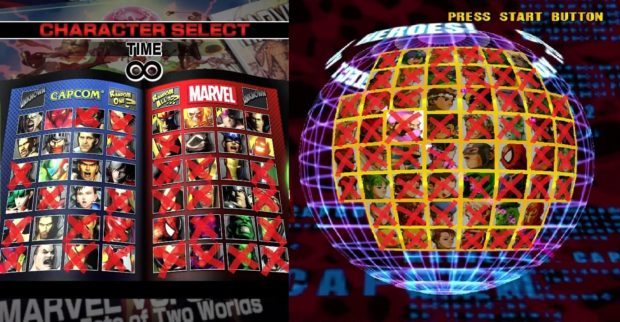
Gameplay-wise, Marvel vs Capcom Infinite is essentially a mixture between the 2nd game in Capcom’s Marvel fighters; Marvel Super Heroes and the original Marvel vs Capcom: Clash of Superheroes.
Unlike MvC2 and UMvC3’s 3v3 mechanics, Infinite goes to roots of the original Marvel vs Capcom by bringing back the 2 vs 2 tag fighting. Another change from UMvC3 is that Marvel vs Capcom Infinite is a fighter with six-button layout controls; including light and heavy versions of punches and kicks, as well as one button for switching characters and another to activate the infinity gem modifier with the Infinity Surge and Infinity Storm moves.
The core fighting mechanics for Marvel vs Capcom Infinite remain the same as the previous MvC games, gameplay that favors stringing juggle-based combos with the use of launchers, dashes, roles air-dashes, super jumps and extending these combos by tagging in partner characters.
Like previous Marvel vs Capcom games, Infinite continues the trend of featuring a very simplified movelist that allows for combos that can come out just by mashing light punch and even the screen filling Hyper Combos can be triggered by simply hitting heavy kick and heavy punch simultaneously.
Even countering combo attacks has been replaced by a simple move that sacrifices two Hyper bars to take control of the partner character to try an assist-like combo breaker via the new Counter Switch mechanic.
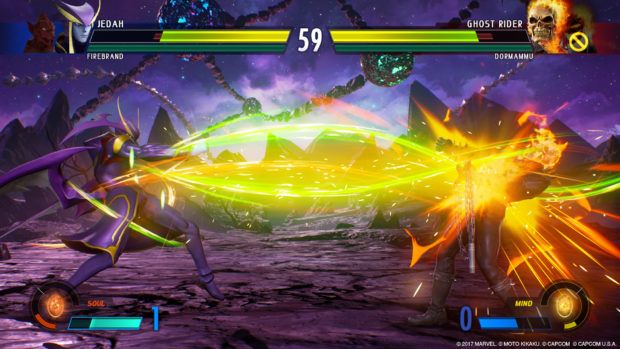
While this ease of execution might make some feel that the game has been dumbed down for the casual audience, this is not the case. There is still a lot of strategy involved in the game and while seemingly easy and simple, its overall fast-paced fighting mechanics follow the ‘easy to learn and hard to master’ mantra and ensure that a button masher cannot continuously defeat a seasoned veteran.
Even though it maintains the same core mechanics as its predecessors, Marvel vs Capcom Infinite changes things up by reintroducing 2v2 tag system; this time, without the crutch of call-in assists that were part of the system since the first MvC.
The game features a “free-form” tag mechanic that lets players immediately switch between their team members at any point, even while mid-air or during attack animations. This makes the game’s fighting much more tag-heavy, incentivizing swapping characters back and forth, and frankly much more dynamic than the manic assist-heavy, long 100+ hit combo gameplay of MvC2 and UMvC3.
Marvel vs Capcom Infinite also makes the design choice of bringing back the Infinity Stone mechanic from 1995’s Marvel Super Heroes. Players are able to choose from 6 infinity stones at the character select screen, each stone containing its own unique property, which can be activated anytime as a one-button “Infinity Surge” move and a super ability called “Infinity Storm” that can be activated after a player fills their Infinity meter.
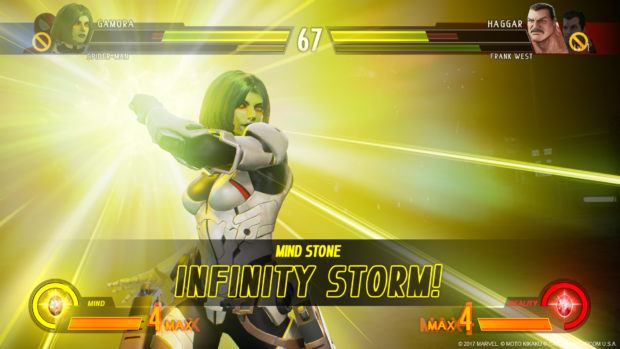
The Reality Stone’s Infinite Surge ability launches an energy burst that homes in on the opponent, while triggering its Infinity Storm move unleashes different elemental attacks based on buttons pressed by the player.
Using Power Stone does powerful attack that launches the enemy backwards, and its Infinity Storm raises the character’s attack power output, where every hit will smash the opponent backwards.
Activating the Space Stone draws the opponent towards your character, while using its Infinity Storm ability seals the opponents in a force cage, restricting their movement for the duration of the storm.
Time Stone allows players to warp-dash a set distance, and its Infinity Storm move raises Active Switch speed and increases speed of combo attacks allowing greater chance to combo from landed attacks.
Mind Stone activation throws an attack that renders the opponent immobile, and triggering its Infinity Storm causes the player’s Hyper Combo meter to rise continuously.
Utilizing Soul Stone’s Infinity Surge move does a far-reaching attack that leaches enemy’s vitality, while its Infinity Storm revives a fallen partner character and rush the enemy simultaneously, fighting as one.
While all of these Infinity Stone powers are wild and inventive, none of these abilities are overpowered and seem to be decently balanced against each other. Although competitive play in the coming months might reveal lopsided advantages or short comings of infinity stones, as well as, infinite combos, broken setups and the size of power gap in the high and low tiered characters within the game’s roster.
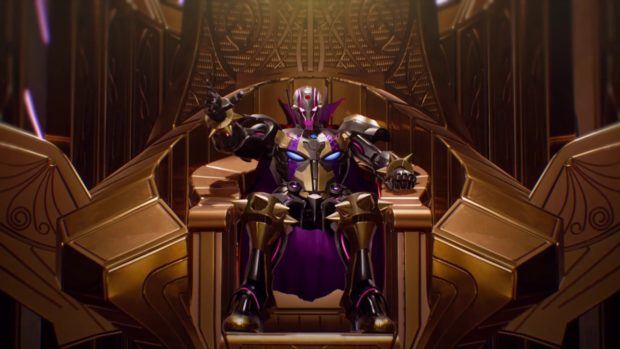
Thankfully Capcom learned from its Street Fighter V debacle and has graciously included an Arcade mode in MvCI, however, as it turns out, the mode is just an underwhelming compilation of vs. CPU battles with a boss fight at the end of the ladder; It contains no context, no cutscenes, no additional dialogues (written or spoken) and completing it doesn’t net the player any character endings.
It seems that Capcom thought that including a Story mode absolves them of putting any effort into a classic arcade mode, whereas Neatherealm Studios made sure that Injustice 2 contained arcade mode endings for each character, in spite of the fact that their game featured a full-fledged, high quality story campaign with amazing production values.
Speaking of which, Marvel vs Capcom Infinite does come with its own Story Mode. Lasting around 3 to 4 hours, this cinematic story campaign is a campy action-packed ride through several Capcom and Marvel properties, that is chalk full of quippy one liners and lots of fan service. Though it doesn’t come close to the quality and length of Injustice 2 campaign, it’s story is more coherent than Tekken 7’s and its production values are better than Capcom’s own efforts in SFV’s ‘A Shadow Falls’ story mode.
Aside from its story mode, MvCI also contains a Mission Mode that, while not as extensive as the tutorial in Guilty Gear Xrd Revelator, contains decent number of tutorials that teach basics of game mechanics including movement, throws, blocks, switching, combos, hyper combos, infinity surge and storm, as well as missions that feature character specific challenges about special moves and combos.
Infinite also includes the usual online-play feature set with Casual and Ranked matches, 8 player lobbies and ability to record and view replays, as well as a separate Beginners League for players ranked 14 and below. Players can also spend time unlocking colours by completing arcade mode or view game’s Collection mode that features cutscenes from Story Mode, game’s music, voices, art-work as well as bios and models for each playable character and their special moves/items.
Despite the amount of its single and multiplayer features, Infinite won’t appeal to anyone who is not excited by prospect of flashy chaotic figher or those that were hoping to play as any of the iconic X-men characters or MvC staples like Dr. Doom, Akuma or Jill.
Although it’s fun and engaging mechanics are let down by uninspired art direction and questionable roster omissions, Marvel vs Capcom Infinite still contains enough content and great gameplay to entertain anyone who is interested in the series’ staple flashy visuals and fast paced combo-heavy gameplay.
